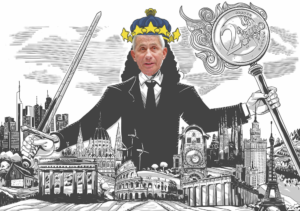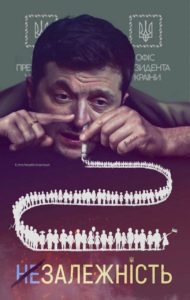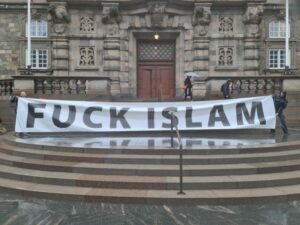Technocracy and the Death of Humanism and The Self

The international pandemic that spread across the globe in 2020 led to a very public debate on who should make public health decisions: experts or policymakers. Politicians in democratic and representative governments are elected by the people to make decisions on their behalf. Experts, which can include individuals like Dr. Fauci, head of the CDC, are typically appointed based on their technical knowledge of their field. President Donald Trump and Dr. Fauci publicly took, at times, adversarial positions. On a state level, appointed Secretaries of Health guided elected Governors through the COVID-19 policy-making decisions.
An example of the technocrat view in the current public health crisis is the Democrat National Committee’s Platform, which shares the following under their section dedicated to COVID-19:
“Democrats believe we must follow the informed advice of scientists and public health experts, and will take steps to protect federal scientists from political influence.”
In Pennsylvania, Secretary of Health Rachel Levine issued orders and advised Governor Tom Wolf on the best course of action to mitigate the spread of COVID-19. The interesting dynamic is many Americans relied on the guidance of technocrats to navigate through a public health crisis and global pandemic despite lacking the same education and training as the appointed experts.
Other elements of the American government that rely heavily on technocrats include the financial sector, specifically the Federal Reserve. The Federal Reserve has 12 banks, which are owned by their member banks. The member banks are financial technocratic institutions owned by private banks.
In 2018, Citi Bank owned roughly 42.8% and J.P. Morgan Chase owned 29.5% of the New York Federal Reserve. Citi bank is privately run by financial experts. Members of the Federal Reserve Board are nominated by the President and confirmed by the Senate, with their economic education and training typically central to their appointment. The Federal Reserve sets interest rates and inflation by buying or selling government back mortgages and bonds from its member banks. Elected officials are not making the decisions that dictate the interest rate or inflation rate.
The benefit of the inclusion of technocrats in decision making is that many policymakers lack intricate knowledge of complex topics, such as novel diseases. The conflict between academics and politicians during Gerald Ford’s Swine Flu Affair highlights the problems caused when technocrats are tasked with guiding politicians.
Richard E. Neustadt wrote The Swine Flu Affair: Decision Making on a Slippery Disease to help guide future administrations with handling potential pandemics. In the review, Neustadt outline the two major questions the Swine Flu Affair posed:
“Indeed, the swine flu experience threw into sharp relief two questions that increasingly challenge officials at the high policy levels of government: First, how shall top lay officials, who are not themselves expert, deal with fundamental policy questions that are based, in part, on highly technical and complex expert knowledge—especially when that nowledge is speculative, or hotly debated, or when “the facts” are so uncertain? When such questions arise, with how much deference and how much skepticism should those whose business is doing things and making policy view those whose business is knowing things—the scientists and the experts?
How should policymakers—and their expert advisers—seek to involve and to educate the public and relevant parties on such complicated and technical issues? To what extent can there be informed and robust public debate before the decision is reached?”
The struggle outlined in the Swine Flu Affair is the role of elected officials and technocrats when facing a novel disease that poses a threat to public health. The role of technocrats in a democracy also is a debate about whether collective benefits outweigh individualism. The death of self is unavoidable in true technocracy, raising valid ethical and moral quandaries that social engineers are not trained or capable of considering.
Liberalism
When the term liberal was coined, its definition was far different than its current use in America. Liberalism was rooted in the belief that individuals knew what was best for themselves and that the government should not prevent the pursuit of those needs. Liberalism believed in a small government that had limited authority over the population and protection of individual and property rights. True liberalism is now referred to as classical liberalism, which in 2020 America would place on the libertarian portion of the political compass.
Liberalism supported limited government intervention in the economy, allowing individuals to participate in trade without interference from the government. Liberalism also supported ideas rooted in the Magna Carta: trial by jury, personal property rights, and due process. The reason the idea of a free market and unregulated trade was radical was that medieval and monarchical economic systems operated within a feudal framework. The ideal free market meant all individuals had an equal opportunity to compete, with consumers choosing the winners.
A Short History of Technocracy
Henri de Saint-Simon sparked the Saint Simonianism movement. “The categorical imperative of Saint-Simonian thought was the call to apply the scientific knowledge of competent experts to the problems of society.” The movement focused on the need for organizing and planning society and placing individuals with social engineering training in positions to administer aspects of society. Decisions were to be made based on the efficiency of the entire society without consideration for natural rights or individual choice. In fact, the movement believed that liberalism was a threat to social order, progress, and efficiency. Robert Carlisle offers the following:
“Saint-Simonianism was not egalitarian or democratic. Liberty, in its eyes, was the result of civilization, not its object. Equality of men’s abilities did not exist, but the validity of men’s needs did. It was to satisfy these needs that Saint-Simon called upon the “industriel” to aid him.”
The “industriel” is a man who works, but he is also the man who works at providing work. The confusion is intentional. It underlines Saint-Simon’s understanding that between employer and employee there exists an identity of interest. Its psychological aim is that of persuading the worker that there is a point to his work. The appeal to the employer is quite other. Throughout his later years Saint-Simon sought to persuade businessmen and bankers that they constituted a class possessing a tremendous power for good which they were not allowed to use. If the chaos, which had existed in Europe and America for a generation, was not to continue, a major social transformation would have to take place.”
From the moment when Saint-Simon camped opposite the Ecole Polytechnique, the polytechniciens were to play a large part in his thought, in his society, and in the discussion and diffusion of his ideas. The Ecole was then home for some of the most brilliant mathematical and scientific minds of the age. Its programs were obviously directed to producing engineers, thus they were technical, pragmatic, and in the eyes of at least one com- mentator, Frederick von Hayek, anti-humanistic. From this set of facts Hayek has argued that the whole scientistic (as opposed to scientific) approach to social and economic problems had its birth at the Ecole Polytechnique. To it, consequently, Hayek argues, we owe our notions of social engineering, planning, and all that we equate with technocracy.“
The Saint Simonian technocracy movement required efficiency of property consolidation and distribution, which was even applied to marriage. The technocrats view marriage not as a human need for love but instead as a method for efficiency, which outlines the anti-humanist element of the movement. The Saint Simonian view of property and marriage was as follows:
“What needs to be recognized is that the Saint-Simonians were convinced of the necessity of modifying the institution of property. That institution led to injustice, conflict, and the repression of both the individual and society. Out of the discussion of the relations of men and women came the recognition that in bourgeois society marriages were made for the sake of property, and that the family existed as the end and object of property accumulation. If the institution of property was to be modified, so must marriage and the family be modified. Further, in marriage and in law, the woman was regarded as a kind of property. The main object of the Saint-Simonians had been to ameliorate the condition of the poorest and most numerous class, and certainly that class included women.”
Simon-Simonianism also viewed children as inconsequential in the context of property and social relation and believed:
“that paternity should be of concern only to the mother. Since inherited property was to be modified, since talent was to be the only passport to success and to property-holding, the identity of children was relatively unimportant.”
The cold logic of the SImon-Simonian technocracy movement raised opposition from liberals, including F.A. Hayek.
Hayek explained the problems of technocracy as:
“ … a whole generation grew up to whom that great storehouse of social wisdom … the great literature of all ages, was a closed book. For the first time in history that new type appeared … the technical specialist who was regarded as educated because he had passed through difficult schools, but who had little or no knowledge of society, its life, growth, problems, and its values which only the study of history, literature.”
Essentially, the anti-humanistic aspect is the result of society placing more value on science than human experiences and history.
In short, a technocratic society would have a managed and planned economy with a handful of experts controlling the economic system. This is reminiscent of feudal systems that prevented the worker or commoner from property ownership or free enterprise.
Social engineering training would not include learning about the human component and ignored the entire field of humanities. While technocrats were experts in math and physics, they lacked an understanding of human emotion and relationships. In fact, the individual was of minimal concern.
The preference for logic caused them to ignore the aspects of individuals that make them human: the capacity to feel emotions and consider those emotions when making decisions. Even a social engineering decision based on facts needs to consider the implications of the application on the populace. If an engineer is concerned only with efficiency but fails to consider that humans can refuse to submit (unlike a machine), the technocrat would be unable to perceive or respond to the invocation of free-will. A technocrat would therefore push for a society where emotions are oppressed in order to assure stability and the efficiency of the entire system.
When marrying, should the couple consider their feelings for each other or the financial and social benefits of their marriage? In advocating for the benefits of choosing to marry solely based on financial and social concerns, the Simon Simonians did not consider whether this would have negative consequences on human development.
For example, if the parents married for reasons other than love, would the children receive the same benefits as children raised by parents who loved each other? Science today says no. Unhappy marriages lead to domestic disputes. Children witnessing these actions are more likely to develop trauma and mental health problems. Children with loving parents have better life outcomes.
The technocrat is not interested in the byproduct and effects of choosing efficiency over human emotion. In doing so, the technocrat is incapable of focusing on the big picture: that humans have free will and may not view as an efficient policy as providing emotional needs.
If a society is based solely on skill and expertise, individuals with disabilities are less likely to succeed, as disabled individuals are less likely to obtain a college degree. That trend is the same for those living in poverty and racial and ethnic minorities. College graduates who come from a low-income background and earn a bachelor’s degree earn 2/3rds of what those with a bachelors from a higher-income background. These trends demonstrate the inherent dangers technocratic political systems pose upon the masses.
Technocracy is simply a modern version of feudalism and right-wing social hierarchy. Individuals born with social status and wealth will benefit most from the implementation of a technocracy.
The Saint Simonian school of technocratic theory relied on mobilizing bankers and industrialists and was not a movement that rested upon the proletariat, but instead the wealthy. The technocrat believes that efficiency allows needs in a society to be met.
This efficiency requires planning and social engineering to achieve. But the technocrat does not consider whether tangible goods and having material needs met leads to more happiness than liberalism. Liberalism believes that the individual knows best what they need and seeks to limit intervention in obtaining those needs.
For example, liberalism allows an individual to choose whether efficiency and materialism bring more value to their life than freedom from the constraints of rulers and society. Liberalism would embrace marriage based on emotions, while technocrats would embrace a marriage that improves familial efficiency (ie, maximizes property, financial assets, and social standing).
Liberalism believes in free enterprise and allowing the individuals in the system to decide how the market operates. For instance, liberalism would believe the business owner has sole discretion in deciding how much to produce. A technocrat believes the business owner should base production solely on societal needs and efficiency and that failing to do so results in a chaotic society.
Members of the elite, such as bankers and industrialists, owned land and significant assets in the 19th century. Their cooperation was necessary to implement a planned society and economy. In order to transition a liberal society to a planned one, the owners of the means of production and banks needed to adhere to a technocratic ideology. To encourage support, Saint Simonianism ensured that the bankers and industrialists would be technocrats and wield influence over the planning of societal issues relevant to their field of expertise.
“The Saint-Simonians, consequently, could count on support from industrialists and bankers insofar as the movement touted these same industrialists and bankers and their role in society. …To the “liberalism” of the Restoration, the Saint-Simonians were clearly and unalterably opposed. Although Saint-Simonianism wooed liberals, its object in doing so was to convert them to socialist rather than to egoist goals. What the Saint-Simonians saw in Restoration liberalism was unchecked egoism, social conflict, duplication of effort, waste, inefficiency, and incompetence in the administration of both things and people.They had a clear notion that in a laissez-faire world of uncontrolled competition somebody wins and somebody loses. They had an almost Marxian intuition that there are more losers than winners.
From these bases, it was a short step to asserting that the man who knew how to do a thing ought to do it; that the man who knew what ought to be done ought to be obeyed.In these notions were the sources of Saint- Simonian authoritarianism, the division of society by capacities, and the slogan ‘from each according to his capacities, to each according to his work.’”
The idea of social progress is the root of technocracy and focuses more on the needs of society as a whole than the individual. Natural rights cave to the needs of the whole, which leads to the death of the individual.
The Federal Reserve
The Federal Reserve was created in 1913 and “in creating the Fed, Congress established an expert, independent agency to manage the country’s monetary affairs.” The Federal Reserve is controlled by appointed officials.
The Federal Reserve Act required all member banks to buy stock in the Federal Reserve System. Member banks loaned the Federal Reserve money and in return received 6% interest on the money loaned. All member banks were required to buy shares in the Federal Reserve in order to operate. Section 2 (3) of the Federal Reserve Act of 1913 states the following:
“When the organization committee shall have designated the cities in which Federal reserve banks are to be organized, and fixed the geographical limits of the Federal Reserve districts, every national banking association within that district shall be required within thirty days after notice from the organization committee, to subscribe to the capital stock of such Federal reserve bank in a sum equal to six per centum of the paid-up capital stock and surplus of such bank, one-sixth of the subscription to be payable on call of the organization committee or of the Board of Governors of the Federal Reserve System, one-sixth within three months and one-sixth within six months thereafter, and the remainder of the subscription, or any part thereof, shall be subject to call when deemed necessary by the Board of Governors of the Federal Reserve System, said payments to be in gold or gold certificates.”
What this means is that member banks were not required to immediately pay the Federal Reserve for the stocks they bought. Member banks only had to provide 1/6th
(16.66%) of the amount of money for the stocks they bought up-front.
For simplicity, if a member bank bought 600 shares of the Federal Reserve, they would need to immediately pay for 100 stocks (the amount was on-call). The member bank would have to provide the capital for an additional 100 shares within 3 months, and another 100 shares in 6 months. The other 300 shares? The Federal Reserve could call them in whenever they deemed necessary. Members of the public were allowed to buy shares only if member banks did not buy all the available shares, meaning private banks got first dibs at buying a chunk of Federal Reserve shares.
In short, bank members did not have to prove or provide liquid cash for the number of shares they obtained in the Federal Reserve. In fact, they only had to have 1/6th (or 16.6%) of the value of the stock they purchased.
In an article for the Brookings Institute, Robert Litan states when discussing centralized banking:
“No modern country operates without one, and it is inconceivable that the United States would prefer to have no central bank–and thus no way to fight financial panics other than to rely on Wall Street financiers, as was the case
before the Fed was created (and policy makers had to trust J.P. Morgan to save the country.)”
In 2018, JPMorgan Chase owned a nearly 30% stake in the New York Federal Reserve. In 2007, JPMorgan Chase owned 41.7% of the shares of the New York Federal Reserve. Clearly, Litan fails to understand that centralized banking and the Federal Reserve system have failed to change the government’s reliance on the JP Morgan banking empire for capital and funding.
JP Morgan helped fund the Allied war effort during World War I:
“Following several hectic months in which the various Allies separately competed for U.S.-made materiel, in January 1915 the British government signed a “Commercial Agency Agreement” with the Wall Street giant of
finance capital, J.P. Morgan & Company. The compact designated the company as the official purchasing agent, at a 1% commission, of U.S.-produced war goods. It gave Morgan a dominant role in financing the Allied war effort and made Britain the Entente’s prime paymaster.
As a result, between January 1915 and April ’17, Morgan became the world’s largest single purchaser of goods as it procured more than $3 billion (in 1913 dollars) in war-related materials for the Allies, with 60% of that total going toward arms and munitions.”
Additionally,
“From August 1914 to April 1917, while the United States was neutral, the Morgan banks worked assiduously to further the Allied cause. Once it was apparent that the war was not going to end imminently, a formal relationship was established linking the House of Morgan and two of the principal Allies. In January 1915, J.P. Morgan & Co. was appointed the British government’s purchasing agent in the U.S.; some months later, in May 1915, they assumed the same position for the French government. Acting through its Export Department, J.P. Morgan & Co. coordinated the
purchasing requirements of the Allies in the United States, a task that became progressively larger as the scope of Allied buying increased. While J.P. Morgan & Co. was never designated Allied financial agent in the United States, the bank floated loans for Britain and France, handled foreign exchange operations, and advised British and French officials.
J.P. Morgan & Co. developed a cordial relationship with Britain, but its dealings with France became strained over the course of the war. Once the U.S. entered the war as an associated belligerent, easing the acute dollar shortage facing the Allies, J.P. Morgan & Co. gradually withdrew from its former role. By 1918, the firm’s work was confined to the liquidation of unsettled matters.
As the war came to a close, it was apparent that the conflict had benefited the United States financially. Pre-war a debtor nation, the U.S. emerged as the strongest financial power in the world. J.P. Morgan & Co., the dominant Wall Street bank, was especially favored by this outcome.”
JPMorgan Chase has also been fined for allowing laundering and other criminal activity, as outlined in the FinCen files. JPMorgan Chase, along with
“HSBC, Standard Chartered Bank, Deutsche Bank and Bank of New York Mellon —kept profiting from powerful and dangerous players even after U.S. authorities fined these financial institutions for earlier failures to stem flows of dirty money. U.S. agencies responsible for enforcing money laundering laws rarely prosecute megabanks that break the law, and the actions authorities do take barely ripple the flood of plundered money that washes through the international
financial system. In some cases the banks kept moving illicit funds even after U.S. officials warned them they’d face criminal prosecutions if they didn’t stop doing business with mobsters, fraudsters or corrupt regimes.
JPMorgan, the largest bank based in the United States, moved money for people and companies tied to the massive looting of public funds in Malaysia, Venezuela and Ukraine.”
JPMorgan has 41 international banks cited in the files, including in China, Russia, Ukraine, the United Arab Emirates, Panama, Switzerland, Pakistan, Barbados, and the Cayman Islands. JPMorgan Chase was named one of the 13 banks to run a trade bank in Iraq in 2003, being appointed to the Coalition Provisional Authority by “Coalition Provisional Authority Administrator L. Paul Bremer on July 13, 2003”. The CPA consisted of 13 banks from 13 different countries.
“The temporary bank’s role is to issue and confirm credit letters to facilitate and encourage immediate importation of items like food, electrical equipment, and oil refinery machinery, and later that will allow for trade in oil and heavy machinery, worth hundreds of millions of dollars and effectively phasing out the UN oil-for-food program.”
JPMorgan Chase also agreed to finance imports for the Trade Bank of Iraq in 2013. In 2019, JPMorgan Chase announced it would stop funding and investing in private prisons and immigration detention centers. In the Public Interest released a report outlining private banking investments in the American prison industry in November 2016, sharing:
“The two private prison industry leaders, Corrections Corporation of America (CCA) and GEO Group, depend on debt financing in the form of credit, loans, and bonds to conduct their day-to-day business operations and acquire smaller companies.
At the end of June 2016, CCA had total debts of $1.5 billion and GEO Group had total debts of $1.9 billion. An analysis of financial documents filed with the U.S. Securities and Exchange Commission (SEC) over the past 10 years
shows that six Wall Street banks play large roles in financing CCA’s and GEO Group’s debts. These six banks—Bank of America, JPMorgan Chase, BNP Paribas, SunTrust, U.S. Bancorp, and Wells Fargo—have (1) extended revolving credit to CCA and GEO Group, (2) provided the two companies with term loans, and (3) underwritten the two companies’ bonds.”
JPMorgan Chase previously heavily invested in private prisons which were run by companies lobbying for increased incarceration:
“Private prison companies rely on debt financing from banks to expand their control of the criminal justice system and immigration enforcement system.
By providing loans to CCA and GEO Group to purchase companies that provide residential reentry and electronic monitoring services, the banks have helped position the private prison companies to receive new business as states and the federal government replace “tough on crime” policies with “community corrections” policies and replace immigration detention policies with immigration surveillance policies.”
In 2016, 1 out of every 38 Americans was under some form of court supervision.
In short, it’s hard to argue that the Federal Reserve system has weakened JPMorgan Chase, as the international bankers continue to fund everything from World Wars to private prisons in the United States. JPMorgan Chase monetizes debt without producing anything of value. Buying shares of the Federal Reserve on credit (or, more specifically, a 16.6% downpayment on a subscription payback plan) means the bank may have never had the assets to pay for its original investment in the Federal Reserve.
The ability of technocrat bankers influencing the criminal justice system, as criminal sentences suddenly impact profits for JPMorgan and its allies, demonstrates the unintended consequences of providing too much power and influence to “experts.” While bankers are likely financial experts, that does not mean their values or policies are meant to benefit the masses or society.
With JPMorgan Chase serving as an example of the international banking technocrats, the idea that a private bank is not only a massive debt holder for the Federal Reserve system but also active in national building and imperialism means the private bank has too much power and influence. JPMorgan is not the only international bank or financial group with this amount of influence in US policy, either.
In Closing
The use of technocrats demonstrates a shift to values that could force a startling transition focused more on process than the human element. A major disadvantage of technocracy is that those with wealth, resources, status, and connections are more likely to obtain the education necessary to achieve expertise in a field. A technocracy, therefore, fails to proportionately represent classes and groups of individuals unlikely to earn professional degrees to qualify as technocrats.
Individuals from wealthier homes are more likely to attend and graduate college than individuals from middle and low-income households. Women and minorities are likewise less likely to have professional degrees and training to work as a technocrat. The more social and economical inequalities that exist in a technocrat society, the less likely those born without wealth, privilege, and status are to have insight and representation in the private and public realm. Hence why multi-generational international banking oligarchs like the Morgan family succeed in controlling power, wealth, and influence for hundreds of years. When your family has 5 generations of financial experience, it makes it difficult to compete for a position within a technocratic system if you are not from a family with extensive education or multi-generational success.
The more individuals rely on technocrats, the more influence they have. The dynamic threatens to return to a monarchy in many ways, with individuals born to technocrats more likely to become technocrats.
Balancing the benefits of technocrats with potential harm is a necessity today. COVID-19 demonstrated the influence technocrats have in public policy, with the Federal Reserve System showing how a handful of wealthy private banks can leverage their financial assets to drive domestic and foreign monetary and fiscal policy. If governments must rely on private international bankers to fund wars and public policy, it strips away the autonomy of the free individual and threatens liberal governments.
If a political system transitions fully to a technocracy, the risk is that the ideology conflicts with democracy. Democracy in this use is simply the ability of the individuals to elect politicians to represent their interests. A technocracy can bypass the voice of the people by improperly ceding control to experts that have a specialized understanding. If the masses lack that training, it can be difficult to discern the intent and validity of the technocrat’s opinion.
Another complication is the type of social hierarchy that can result by putting more faith in elite technocrats than humanism. Transitioning to a system that always places logic and pragmatism above human emotion and ethics can lead to abuses, examples of which are widespread throughout history.
Technocrats may use their unique understanding to compel others to submit to their judgments and opinions. If technocrats believe those without expertise are unable to understand or contest them, then what happens if financial technocrats believe that the commoner is unable to manage their own assets?
Technocracy has viable applications in a democratic society. Ensuring that individuals with unique or special expertise can be used to guide policies can improve policymaking. However, the consequences of a system built on education and status destroy humanism and equality. Choosing pure logic and efficiency above human emotion is a risk that humanity can not afford to take. When humans are viewed as chess pieces on a board, it becomes easier to propagate dangerous ideologies like eugenics.







